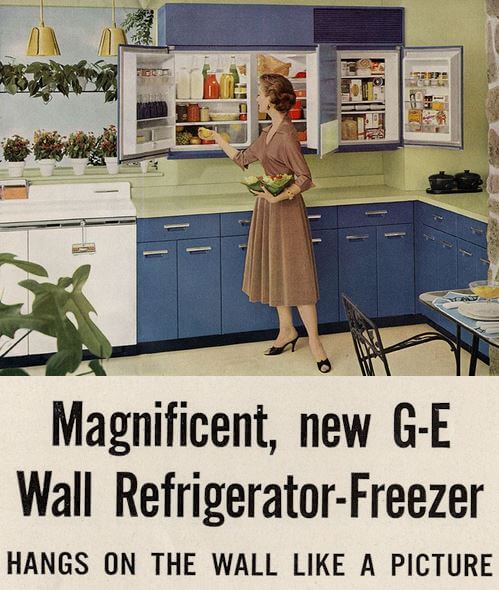 The GE wall refrigerator-freezer is the vintage kitchen appliance that perhaps draws the most gasps from readers when they see one for the first time. And, it’s one of the appliances that inspires many folks to ask, “Why don’t they make this today?” Why did it disappear? I have a few hypotheses. According to the copy in these marketing materials (part of my personal collection), the GE wall refrigerator-freezer was introduced in 1955 — the same year that GE introduced the Wonder Kitchen and a whole suite of kitchen appliances all meant to encourage the “built-in” look.
The GE wall refrigerator-freezer is the vintage kitchen appliance that perhaps draws the most gasps from readers when they see one for the first time. And, it’s one of the appliances that inspires many folks to ask, “Why don’t they make this today?” Why did it disappear? I have a few hypotheses. According to the copy in these marketing materials (part of my personal collection), the GE wall refrigerator-freezer was introduced in 1955 — the same year that GE introduced the Wonder Kitchen and a whole suite of kitchen appliances all meant to encourage the “built-in” look.
Here’s what the ad says about this exciting new invention:
… This magnificent refrigerator-freezer that hangs from the wall provides a completely new and advanced concept of modern living. Truly, it is the most convenient and magnificent refrigerator-freezer ever produced!
The advantages of this new G-E Wall Refrigerator-Freezer are obvious: there’s no need to bend or stoop for foods because everything can be seen at a glance… It can be installed directly above a work counter to provide extra counter surface. And, there’s room in the kitchen for extra base cabinets because this compact new appliance occupies no floor space.
…Six Mix-or-Match colors including white.
Specs: “This de luxe refrigerator-freezer has 10.7 cubic feet of storage room — 8.7 cubic feet for fresh food and 2 cubic feet for frozen foods. It is 5 feet 4 inches long, 3 feet 3½ inches high and 17½ inches deep.
- Long-lasting baked enamel with a wide band of textured aluminum.
- All 3 doors are kept shut by famous alnico magnets. No handles, no catches.
- Separate vegetable and fruit compartments have transparent sliding doors.
- Top shelf provides space for tall bottles. Shelves are adjustable to various levels.
- Separate compartments inside door or butter, egg rack; and door shelves for small jars and cans.
- Zero-degree food freezer has room for up to 83 packages of frozen foods.
- Four new-style Mini-Cube® ice trays.
- Frozen fruit juice storage rack.
- Dependable whisper-quite ealed-in G-E refrigeration unit is built into the refrigerator. No need to install it separately.

Above: Note the special hanger gear on the wall. Readers experienced with this units advise: If you find one to buy for your kitchen, Be Sure to Get The Hanger Thingie!
I don’t think I’ve ever seen one of these “live” working in a reader’s kitchen. But I see no reason that these could not still be used. They may require some refurbishing.
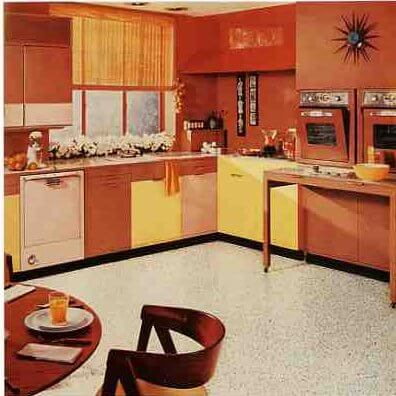
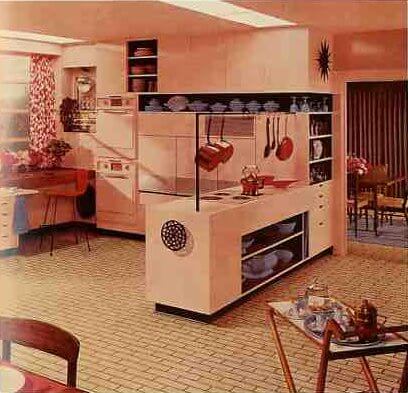
Above: Another interior design from Armstrong floors — Note here, how the GE wall refrigerator-freezer unit is built into an appliance wall. Cool to the max. Plus: Love that floor!

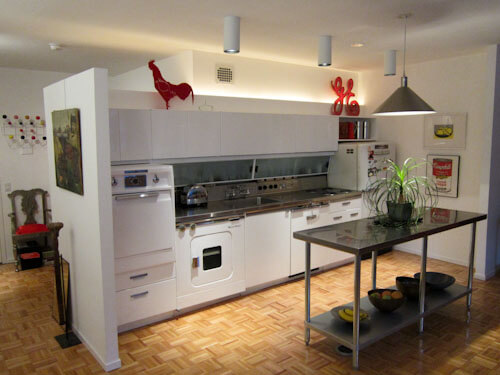
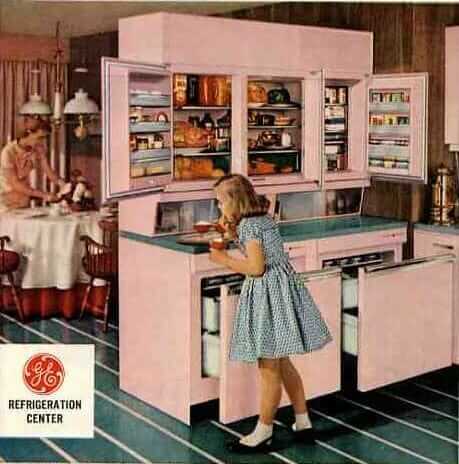
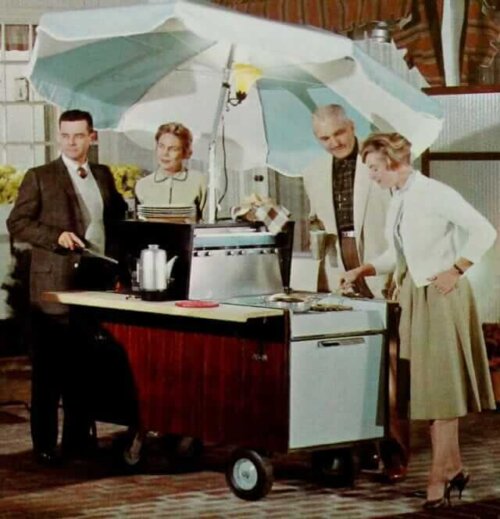
Why did GE wall refrigerator-freezers fade from the marketplace?
I hypothesize: (1) An 8.7 cu.ft. refrigerator was not “enough”, especially as manufacturers continued to offer new, larger refrigerator designs. (2) Kids could not reach the refrigerator. (3) Many women [average height was 5’4″, I remember reading once] themselves had trouble reaching. (4) I’m guessing these were expensive.


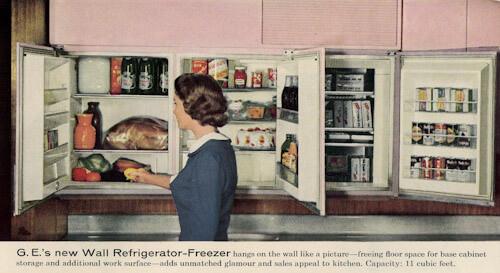

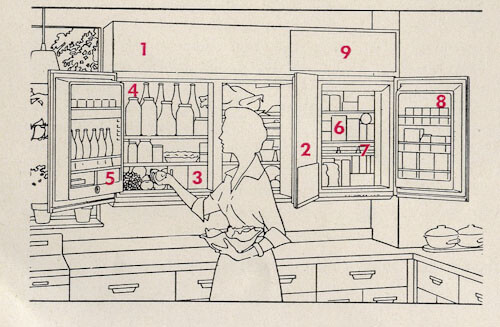

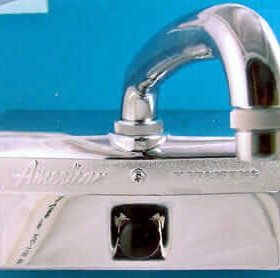
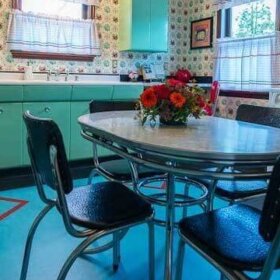
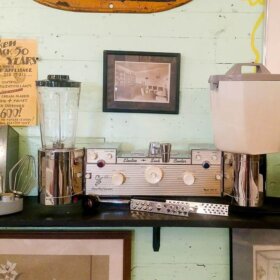

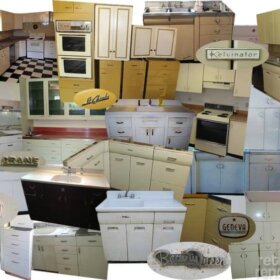

Deb says
We’re still using the vintage wall fridge. The reason is because there isn’t any room in our kitchen for a stand up one! And no possible way to remodel our kitchen to accommodate one. Do you know if anyone makes a newer model for replacement? Repairmen are getting harder to find each year. Yesterday’s repairman ‘guessed’ at what may keep the old girl running, then shook his head and said, “I’m glad this is your problem and not mine!” I think that when the condenser breaks we’re in deep trouble. Yikes!
Erica says
My mom had a good friend whose mother had one of these in her all-pink kitchen, and as of 1989, it was still working.
Dani in Portland says
I found one of these wall fridges in turquoise last year on craigslist. The guy wanted $150 but I talked him down to $100 because the outside was a little beat up. But the inside . . . the inside is pristine, and it even came with the original manual.
It’s still in my garage because it’s intended for a basement renovation, where I plan to add a little mother-in-law unit. I agree with Pam about the reasons why these beauties probably didn’t survive the test of time–and after trying to design a compact-yet-not-overly-small kitchen with one of these, I have another conjecture.
These units are about 19″ deep by 5′ long by about 39″ high if memory serves. Not deep enough to justify taking up under-counter space, but slightly deeper than most upper cabinets. That’s not the hardest part to work around, however. What’s been proving to be the most difficult design problem is having adequate counter space.
I’m aiming for a 12′ line kitchen, where all appliances and counters are in a continuous line. I have the matching wall oven. And I intend to install a new 24″ gas cooktop (which needs an exhaust fan/vent above). Then there’s the sink (~25″ wide), work space (countertop), and storage space (cabinets). This hasn’t even taken an 18″ dishwasher into consideration!
Once you start to try to piece this puzzle together, you realize that the wall fridge + wall oven + cooktop combo requires a big kitchen! You can’t put a cooktop over any other electrical appliance, and if mounted at the correct height, the bottom of the wall fridge almost touches a 36″ tall countertop.
Needless to say, it’s somewhat of a logistical gremlin, unless you have lots of space to play with. I’ve done one set of drawings, but I’ll probably redesign the kitchen again around that fridge, meaning that the entire apartment design depends, to some extent, on that refrigerator.
In other [somewhat related] news, I’ve got a repairman coming out to fix my 1962 Aztec Copper manual defrost Frigidaire fridge this week. It took a long time to track down someone who would even come to look at it, but if you live in a city and you call around, you’ll probably find someone who knows someone. Even if it will cost me $300-$500 to fix (the range quoted over the phone), it’s worth it. Especially when the lifespan of a new fridge is 10 years, if that. (automatice.org sells repair manuals for some of these old appliances. That’s helpful when you get new-timers diagnosing your issue as a problem with a part that your appliance doesn’t even have, e.g. a condenser fan. That’s when you know to move on to the next guy.)
Dani
pam kueber says
oooooh, I can’t wait to see your mil kitchen when it’s done.
Barb S. says
Dani, I can’t wait to see your kitchen too! I might be repeating myself on every post… but please be sure to reinforce the wall you intend to hang that fridge on. I am sure you know how heavy it is. I’m pretty sure the wall mine is hanging on has steel studs, and the wall is sitting on a steel I-beam. Another person I met with a hanging refrigerator had it attached to the back of his fireplace. I can’t imagine plain old wood studs will hold it.
Also, the counter space! haha. Complete waste of five feet under my fridge. …unless you can find those Cabinettes that go underneath like in the ad above. I would LOVE to have those.
Good luck!! Barb
Dani in Portland says
Thanks Pam and Barb! You’re right, a 2×4 stud wall probably wouldn’t be adequate, especially if mounting other cabinets on the same wall. I’m actually considering putting it on a ledger bolted directly to the basement foundation. That way, I’d save some depth because I could frame the interior finished walls around it.
But if it ever breaks down, it’s gonna become a very well-insulted cabinet.
Sharon Rexroad's Bringing Creativity 2 Life says
Dani — I grew up in a house with this fridge, wall oven & stove top and it wasn’t a large kitchen. It did use two walls, however. Let me describe the layout.
Wall #1: Fridge/Freezer upper left, gap just wide enough for one of those towel calendars (18″), Wall Oven. Cabinets stretched under the fridge/freezer & gap. Cabinets under (and maybe over?) oven.
Wall #2: 2″ from front of oven to pocket door opening to front entry hall, 12-18″ of wall (enough so someone coming in the door wouldn’t hit your butt), then start appliances again that face the opposite wall.
Wall #3: Stove top with cabinet underneath and wall cabinet above. Smallish (double?) sink with small window above it (and a sprayer that had a band that matched the yellow GE kitchen!), then cabinet below that was same width as a standard dishwasher. Upper cabinets to match PLUS a third narrow cabinet that hung over a peninsula.
Wall #4: Actually, not a wall, but a peninsula with a rounded end (with shelves!) and a cabinet under the peninsula. Then a gap to get into the dining area.
And now you’re back to the wall hung refrigerator with cabinets underneath!
Tina Swain says
We had one of these in our kitchen while growing up.
It was mounted on a wall with three metal drawers and cabinets under the refrig. The other wall had a one piece stainless counter that had…. going from right to left, 4 burners set in the stainless running seamlessly over the dishwasher, dipping down into a large single sink and then up and seamlessly over the combo washer/dryer. The upper were metal cabinets with sliding glass doors. It is all still there.
The dishwasher is not being used and the refrig/freezer dies as well as the washer/dryer. My single brother lives there and cooks very little but loves to trip down memory lane. Our mom who had my dad remodel the kitchen in the 50’s just passed away at the age of 95.
pam kueber says
A GE Wonder Kitchen – ? –> https://retrorenovation.com/2013/04/08/ge-wonder-kitchen/
Dianne says
I currently have one of these refrigerators in my kitchen and it has unfortunately stopped working. Does anyone have an idea of where I can get a replacement?
Dani in Portland says
You may have better luck with getting it repaired. Just be sure to find a CFC-certified repair person–ideally someone who’s been doing it a long, long time. And you may be able to track down a service manual online, to educate yourself when looking for a qualified professional.
anita says
We had one in our house when we bought it in 1973. I was a kid then and loved it. It was a turquoise blue and it matched the stove and oven which is still in working condition. Our kitchen is big and the fridge was not practical, so my dad removed it an built cabinets in place of the fridge. He also made a place for a standard sized fridge. I am not sure wht he did with the wall mounted one, but I am sure he sold it. U would love to have another turquoise one to put in my basement by the bar.
Carrie Stoltz says
I love and want one of the refrigeration centers. Why are these not made to put in kitchens now? Use my kitchen as a trial run. This is a amazing set-up to have in a kitchen. In stainless. BRING IT BACK!
Anne Walker says
This is a 2fer response that should have gone to Carrie: Funny, I just mentioned to a friend yesterday that I’m probably not going to ever find 1 of these pink hanging refrigs. Then comes a message from this group. LOL!!! I’m with you Carrie Stoltz!!! it also occurred to me that the link to the picture I sent of my kitchen, doesn’t show the spot where the fridge once was. SMH.
Welmoed Sisson says
I just saw one of these in pink at the Second Chance warehouse on Ridgely Street in Baltimore, MD. It was upside down and I couldn’t see whether it was in working condition, but the cabinet looked pretty good. I’d be happy to send pictures if anyone is interested. No, I didn’t buy it and don’t know what the price is, but this place always seems to have vintage kitchen appliances.
Linda DeVlieg says
I have seen a few homes here for sale that have had the original cabinet type refrigerators, and thus no space for a regular fridge; people are always stumped with ‘what are those cabinets for and where does my fridge go?’ I’ve always thought these would be amazing!
Joanne says
Bring back that standalone unit – the last picture of the pink unit. I would love that in my kitchen. I have a 50’s kitchen. The countertop is pink and this would go so well. It also looks very consumer friendly and it doesn’t stick way out past the countertop. As I said, I would love that.
Anne Walker says
Still looking in St. Louis Metropolitan area…